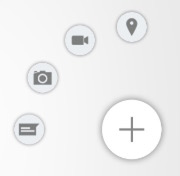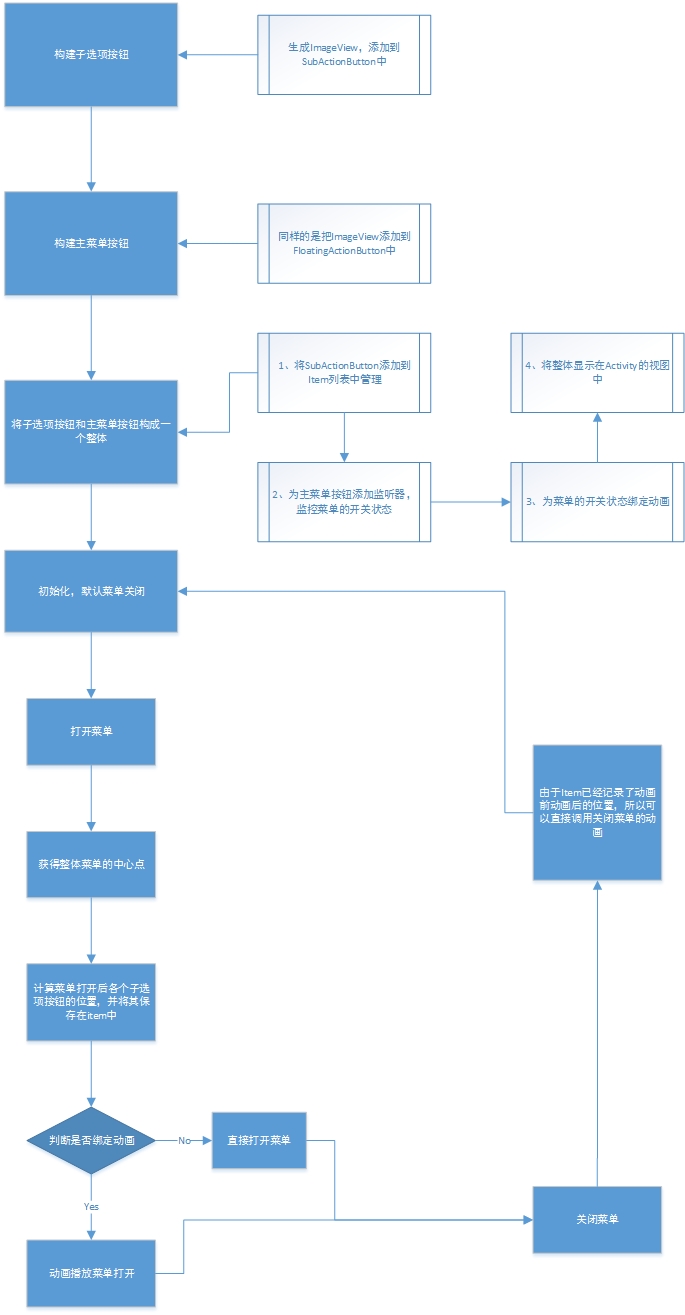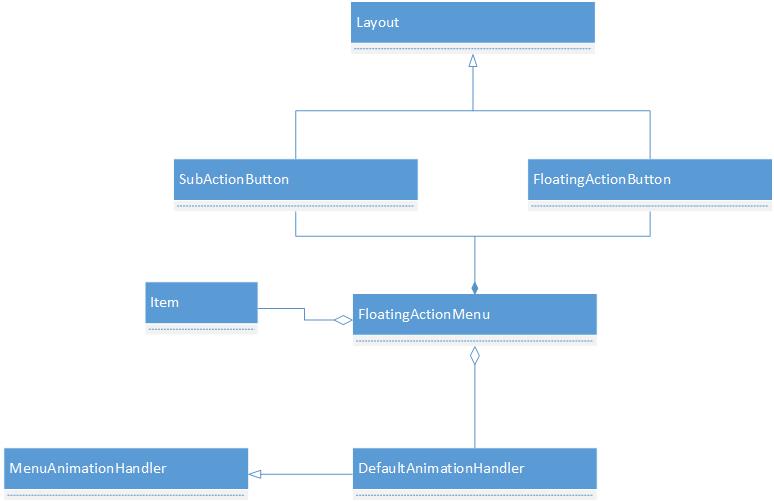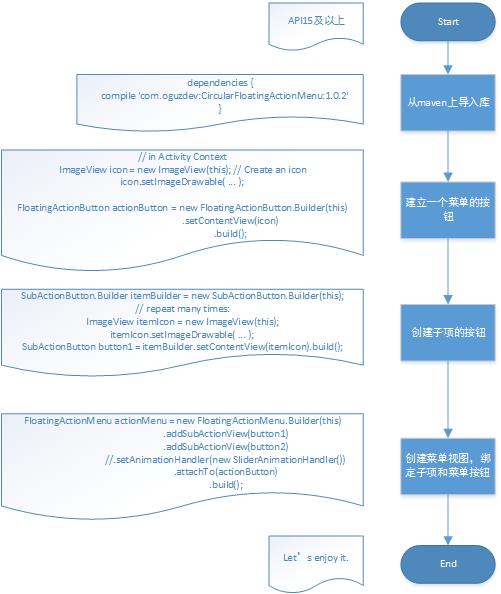CircularFloatingActionMenu 源码解析
本文为 Android 开源项目源码解析 中 circular-foating-action-menu 部分
项目地址:CircularFloatingActionMenu,分析的版本:8efb1aa,Demo 地址:CFAMenu-demo
分析者:cpacm,校对者:dkmeteor、Trinea,校对状态:进行中
1. 功能介绍
一个与著名应用 Path 菜单类似的圆形弹出菜单,可方便的定制菜单以及动画。
菜单可能是非完整圆形,本文统称为圆形菜单。
1.1 特点
可自定义动画、菜单、角度范围、半径等。
1.2 概念

以上是简单的圆形弹出菜单示例,更详细的示例图见:Screenshot。
菜单按钮(Event):点击会弹出圆形菜单的控件,如上图的 + 对应控件,对应代码中的FloatingActionButton.java。
子菜单按钮(Event):圆形菜单中的控件,如上图的定位、视频、相机、文本对应的控件,对应代码中的SubActionButton.java。
菜单:整个菜单,包含上面的菜单按钮和子菜单按钮,对应代码中的FloatingActionMenu.java。
菜单动画回调:点击菜单按钮弹出子菜单按钮的动画设置的抽象类,对应代码中的MenuAnimationHandler.java。
2. 总体设计
本项目较为简单,总体设计省略。
3. 流程图

流程图如上图所示,中间最复杂的可能是计算子菜单按钮位置的地方。
4. 详细设计
4.1 类关系图

以上是CircularFloatingActionMenu主要类的关系图。
FloatingActionButton、SubActionButton都是继承自FrameLayout的自定义控件,可支持以其他 View 为内容,如ImageView、TextView。
FloatingActionMenu由FloatingActionButton、SubActionButton以及MenuAnimationHandler等构成。
4.2 类功能介绍
CircularFloatingActionMenu源码主要分成两部分,一部分是构成菜单的 View 部分,另一部分是动画的操作类。
View 部分包含我们上面提到的菜单按钮FloatingActionButton.java、子菜单按钮SubActionButton.java、菜单FloatingActionMenu.java。
动画部分包含菜单动画回调抽象类MenuAnimationHandler.java以及它默认的实现DefaultAnimationHandler.java。
4.2.1 SubActionButton.java
子菜单按钮,即按菜单键弹出来的选项按钮。这个类继承自FrameLayout,实现一个自定义图标的功能。
可以根据构造函数传进来的参数来选择不同风格的图案底纹,然后将其传给FloatingActionMenu以便控制。
首先是构造函数
public SubActionButton(Activity activity, LayoutParams layoutParams, int theme, Drawable backgroundDrawable, View contentView, LayoutParams contentParams) {
super(activity);
setLayoutParams(layoutParams);
// If no custom backgroundDrawable is specified, use the background drawable of the theme.
if(backgroundDrawable == null) {
if(theme == THEME_LIGHT) {
backgroundDrawable = activity.getResources().getDrawable(R.drawable.button_sub_action_selector);
}
else if(theme == THEME_DARK) {
backgroundDrawable = activity.getResources().getDrawable(R.drawable.button_sub_action_dark_selector);
}
else if(theme == THEME_LIGHTER) {
backgroundDrawable = activity.getResources().getDrawable(R.drawable.button_action_selector);
}
else if(theme == THEME_DARKER) {
backgroundDrawable = activity.getResources().getDrawable(R.drawable.button_action_dark_selector);
}
else {
throw new RuntimeException("Unknown SubActionButton theme: " + theme);
}
}
else {
//通过 mutate()方法解决 Drawable 共用一个内存空间的问题
backgroundDrawable = backgroundDrawable.mutate().getConstantState().newDrawable();
}
//设置背景(考虑版本问题)
setBackgroundResource(backgroundDrawable);
if(contentView != null) {
//添加 view(即菜单的选项视图)
setContentView(contentView, contentParams);
}
setClickable(true);
}
从构造函数可以看的出来,选项按钮有四个主题可以选择,分别是下面的四种颜色
public static final int THEME_LIGHT = 0;
public static final int THEME_DARK = 1;
public static final int THEME_LIGHTER = 2;
public static final int THEME_DARKER = 3;
之后是设定 ImageView 到这个按钮上,并且设定与父 View 的距离。(通过 setMargins())
这个我们在创建 subActionButton 时就要调用。核心函数是 addView(contentView, params)。这个方法能够在视图上再添加一个 view,作为子视图。
/**
* Sets a content view with custom LayoutParams that will be displayed inside this SubActionButton.
* @param contentView
* @param params
*/
public void setContentView(View contentView, LayoutParams params) {
if(params == null) {
params = new LayoutParams(LayoutParams.WRAP_CONTENT, LayoutParams.WRAP_CONTENT, Gravity.CENTER);
final int margin = getResources().getDimensionPixelSize(R.dimen.sub_action_button_content_margin);
params.setMargins(margin, margin, margin, margin);
}
contentView.setClickable(false);
this.addView(contentView, params);
}
最后就是一个建造器了,专门生成用于生成该类的建造器,静态全局
/**
* A builder for {@link com.cpacm.library.SubActionButton} in conventional Java Builder format
* 菜单选项的建造器
*/
public static class Builder {
...
public SubActionButton build() {
return new SubActionButton(activity,
layoutParams,
theme,
backgroundDrawable,
contentView,
contentParams);
}
}
传入 activity,视图特性配置,主题的 id,背景图,imageview(子视图),imageview(子视图)的特性配置。用这些来配置选项按钮。
4.2.2 FloatingActionButton.java
菜单按钮,点击会弹出圆形菜单的控件。
这个类跟SubActionButton基本相似,同样可以通过内部自定义的build构造器来定制自己的按钮。
菜单按钮其实跟选项按钮的代码模式差不多,也是由设定子视图和一个建造器组成。
不过它多了几个方法:
设定位置,如左下,右下等方位
/**
* Sets the position of the button by calculating its Gravity from the position parameter
* @param position one of 8 specified positions.
* @param layoutParams
*/
public void setPosition(int position, FrameLayout.LayoutParams layoutParams) {
int gravity;
switch(position) {
...//具体代码请自行查看源代码
}
layoutParams.gravity = gravity;
setLayoutParams(layoutParams);
}
将视图绑定到 activity 的主视图中。这样我们就能在 activity 的主视图中操作这个 view 了。 FloatingActionButton 的建造器
/**
* A builder for {@link com.cpacm.library.FloatingActionButton} in conventional Java Builder format
*/
public static class Builder {
...
public FloatingActionButton build() {
return new FloatingActionButton(activity,
layoutParams,
theme,
backgroundDrawable,
position,
contentView,
contentParams);
}
}
比 SubActionButton 多了一个位置的属性。
4.2.3 FloatingActionMenu.java
那么最重要的类来了,FloatingActionMenu表示整个菜单,它存放着所有的按钮以及动画操作。
基本结构图如下:
这个类也是由一个建造器生成,那么我们从建造器开始说起
我们先看看生成 Menu 的代码:
FloatingActionMenu rightLowerMenu = new FloatingActionMenu.Builder(this)
.addSubActionView(rLSubBuilder.setContentView(rlIcon1).build())
.addSubActionView(rLSubBuilder.setContentView(rlIcon2).build())
.addSubActionView(rLSubBuilder.setContentView(rlIcon3).build())
.addSubActionView(rLSubBuilder.setContentView(rlIcon4).build())
.setAnimationHandler(new SliderAnimationHandler())
.attachTo(rightLowerButton)
.build();
- Builder(this) 将 activity 传入 menu 中
- addSubActionView 添加选项按钮到 activity 的视图中。在 FloatingActionMenu 中管理 SubActionView 是一个 Item 的 list 集合,每次加一个按钮就往里面添加。Item 是一个辅助类,里面包括一个视图,x 坐标,y 坐标,长度,宽度。
- setAnimationHandler 则是设定动画。
- attachTo 是将 menu 与 activity 的视图绑定。(即把菜单按钮的视图添加到 activity 的视图中)
FloatingActionMenu 类主要是管理菜单按钮和选项按钮的位置和状态(开和关)
(1)首先是通过 view 的 onClick 监听器来控制状态
(2)开关主要是两种状态,开的时候会获得菜单按钮的中心位置 center(getActionViewCenter())和计算 item 的位置(calculateItemPositions())。然后发送动画的请求到 AnimationHandler 中(animationHandler.animateMenuOpening(center))。
/**
* Simply opens the menu by doing necessary calculations.
* @param animated if true, this action is executed by the current {@link MenuAnimationHandler}
*/
public void open(boolean animated) {
...//具体代码请自行查看源代码
}
其中 item 的 x,y 是记录视图的终点位置,然后经过动画把 view 移到 x,y 的位置上。
stateChangeListener 为状态变化的监听器,开关都会响应相应的方法。主要在 AnimationHandler 中添加具体方法。
/**
* A listener to listen open/closed state changes of the Menu
*/
public static interface MenuStateChangeListener {
public void onMenuOpened(FloatingActionMenu menu);
public void onMenuClosed(FloatingActionMenu menu);
}
(3)计算位置
/**
* Calculates the desired positions of all items.
*/
private void calculateItemPositions() {
...//具体代码请自行查看源代码
}
4.2.4 MenuAnimationHandler.java
这是是所有动画类的父类,它主要定义了菜单打开,关闭,以及运行结束后状态的保存的方法。
animateMenuOpening(Point center)
animateMenuClosing(Point center)
restoreSubActionViewAfterAnimation(FloatingActionMenu.Item subActionItem, ActionType actionType)
4.2.5 DefaultAnimationHandler.java
这一个默认的动画类,当我们不对动画做修改时就会默认使用这个类里面的动画效果。我们也可以参考这个类来进行设计新的动画效果。
动画效果主要是通过ObjectAnimator.ofPropertyValuesHolder(menu.getSubActionItems().get(i).view, pvhX, pvhY, pvhR, pvhsX, pvhsY, pvhA)来实现。
动画实现的主要类,继承自 MenuAnimationHandler
主要通过 Animator 来实现属性动画。
里面有一个 restoreSubActionViewAfterAnimation 的方法,它主要是恢复选项按钮到未打开的状态。
/**
* Restores the specified sub action view to its final state, accoding to the current actionType
* Should be called after an animation finishes.
* @param subActionItem
* @param actionType
*/
protected void restoreSubActionViewAfterAnimation(FloatingActionMenu.Item subActionItem, ActionType actionType) {
...//具体代码请自行查看源代码
}
Animator 属性动画以及其他动画的实现请参考我写的博客
Android 的动画效果
4.3 如何使用
// Set up the white button on the lower right corner
// more or less with default parameter
ImageView fabIconNew = new ImageView(this);
fabIconNew.setImageDrawable(getResources().getDrawable(R.drawable.ic_action_new_light));
FloatingActionButton rightLowerButton = new FloatingActionButton.Builder(this)
.setContentView(fabIconNew)
.build();
SubActionButton.Builder rLSubBuilder = new SubActionButton.Builder(this);
ImageView rlIcon1 = new ImageView(this);
ImageView rlIcon2 = new ImageView(this);
ImageView rlIcon3 = new ImageView(this);
ImageView rlIcon4 = new ImageView(this);
rlIcon1.setImageDrawable(getResources().getDrawable(R.drawable.ic_action_chat_light));
rlIcon2.setImageDrawable(getResources().getDrawable(R.drawable.ic_action_camera_light));
rlIcon3.setImageDrawable(getResources().getDrawable(R.drawable.ic_action_video_light));
rlIcon4.setImageDrawable(getResources().getDrawable(R.drawable.ic_action_place_light));
// Build the menu with default options: light theme, 90 degrees, 72dp radius.
// Set 4 default SubActionButtons
FloatingActionMenu rightLowerMenu = new FloatingActionMenu.Builder(this)
.addSubActionView(rLSubBuilder.setContentView(rlIcon1).build())
.addSubActionView(rLSubBuilder.setContentView(rlIcon2).build())
.addSubActionView(rLSubBuilder.setContentView(rlIcon3).build())
.addSubActionView(rLSubBuilder.setContentView(rlIcon4).build())
.setAnimationHandler(new SliderAnimationHandler())
.attachTo(rightLowerButton)
.build();
如以上代码所示
(1)先建立一个 view 来作为一个总容器,设置好图片,然后作为菜单的按钮
(2)建立好选项菜单的视图,添加属性后,添加到 FloatingActionMenu 中的 ArrayList
(3)如果使用自己定义的动画,setAnimationHandler(new SliderAnimationHandler())。
这样子,一个简单的案例就做好了

5. 杂谈
动画的类型有点少,以及在屏幕尺寸异常的机子上测试时(如 mx3 的 1800x1080)会出现子选项偏离中心菜单键的问题,原因出在 view 的位置计算上,它没有考虑到一些特殊机型的机子。
